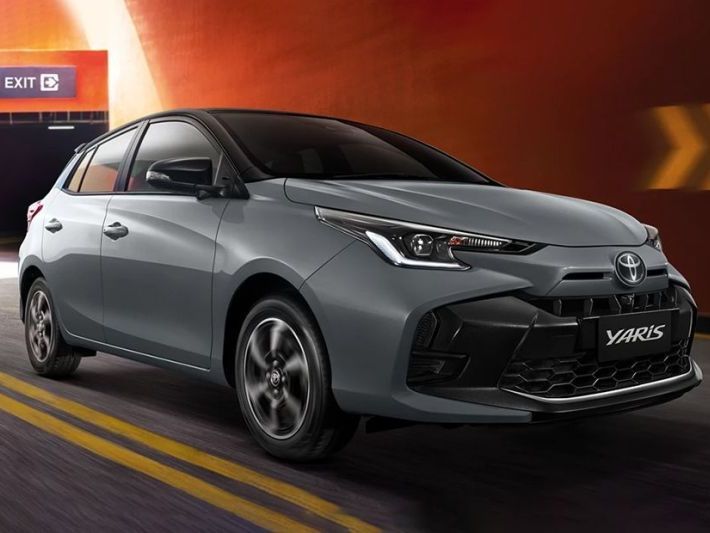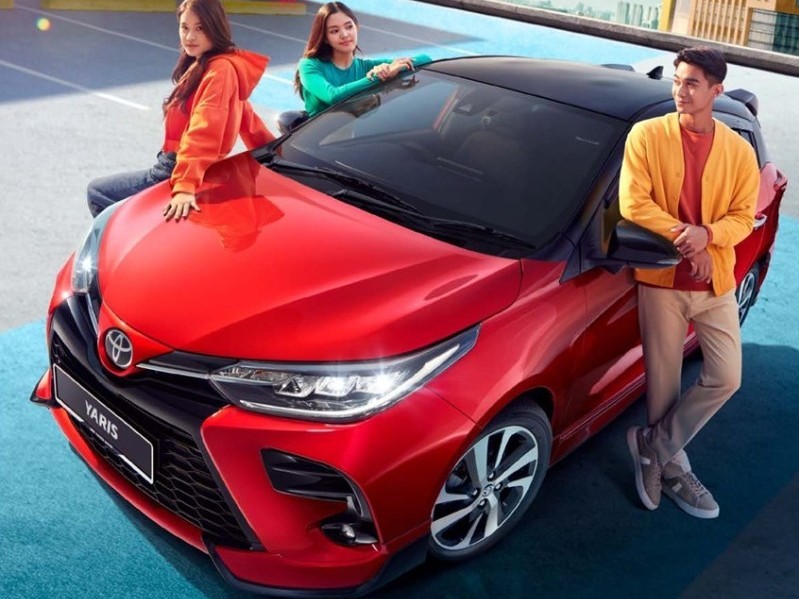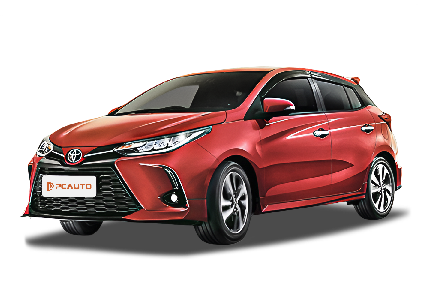Q
How to check transmission fluid 2019 Toyota Yaris?
To check the transmission fluid in a 2019 Toyota Yaris, first make sure the vehicle is parked on level ground and start the engine to let the transmission reach operating temperature (usually after driving for 10-15 minutes). Shift through all gears briefly, then return to Park and engage the parking brake. Open the hood and locate the transmission dipstick (typically with a red or yellow handle, near the firewall). Pull out the dipstick, wipe it clean, reinsert it fully, then pull it out again to check the fluid level—it should be within the "HOT" marks. Also inspect the fluid color (normally clear red; if it's black or has a burnt smell, it needs to be changed promptly). Note that some newer Yaris models may have a sealed transmission without a dipstick; these require a professional technician with special tools to check or replace the fluid. Regularly checking the transmission fluid protects the drivetrain effectively. It's recommended to replace it every 40,000-60,000 kilometers or as specified in the maintenance manual. If you frequently drive in stop-and-go traffic, you can shorten this interval slightly. Using non-genuine fluid may cause gear-shifting hesitation or transmission damage, so Toyota's original ATF WS fluid is recommended.
Special Disclaimer: This content is published by users and does not represent the views or position of PCauto.
Related Q&A
Q
What is the sport mode on a 2019 Toyota Yaris?
The Sport Mode on the 2019 Toyota Yaris is a drive mode selection feature that primarily enhances power response and handling by adjusting the vehicle's electronic control systems. When activated, the transmission delays upshifts to keep the engine in a higher rev range, delivering quicker acceleration, while the steering might feel slightly heavier to improve road feedback. This mode works best for highway overtaking or mountain road driving, letting the 1.5L naturally aspirated engine stretch its legs a bit more. Keep in mind, though, that Sport Mode does bump up fuel consumption slightly, so it's best used for short bursts when you need that extra zip. Rivals like the Honda Jazz or Mazda 2 offer similar modes too, but each has its own tuning—some focus on linear acceleration, others on sharpening cornering stability. Running Sport Mode all the time could speed up wear on the drivetrain, so make sure to check your transmission fluid and engine condition regularly. Also, pairing it with the manual shift function can take the driving experience up another notch.
Q
What engine does a 2019 Toyota Yaris have?
The 2019 Toyota Yaris offers a range of engine options across different markets, with specific configurations varying by trim level and regional specs. Common powerplants include a 1.5-liter four-cylinder naturally aspirated engine (badged 1NZ-FE or an updated variant), pushing out around 107 horsepower. This unit pairs with either a 5-speed manual or 4-speed automatic transmission. Higher-spec models might upgrade to a more efficient 1.2-liter turbocharged engine or a hybrid system. Known for reliability and fuel efficiency, this engine uses Dual VVT-i variable valve timing to optimize low-end torque and high-speed power delivery—perfect for city driving. It’s worth noting that the same-generation Yaris also spawned the GR Sport variant, packing a more potent 1.6-liter turbo engine, though these performance models are pretty rare locally. For maintenance, stick to the 10,000 km or 6-month interval for full synthetic oil changes, and regularly clean the throttle body to keep the engine running efficiently. Toyota’s factory 100,000 km warranty is a nice bonus too, helping cut down on long-term repair costs. If you’re eyeing a used Yaris, pay extra attention to the engine mount bushings and timing chain condition—these are common wear items on higher-mileage examples.
Q
Is the 2019 Yaris a Mazda?
The 2019 Yaris isn't a Mazda; it's a classic compact car from Toyota. However, it's worth noting that in some markets like North America, Toyota collaborated with Mazda to launch the Yaris iA (later renamed Mazda2 Sedan), which was based on the Mazda2 platform. But that's different from the Yaris models commonly seen locally. The 2019 Yaris sold locally was still Toyota's independently developed third-generation model (XP150), powered by a 1.5L naturally aspirated engine, focusing on affordability, practicality, and reliability. Its design and technology were all from Toyota, such as standard VSC vehicle stability control and seven airbags for safety. It's important to note that platform sharing or joint production between car brands is common in the industry. For example, Toyota also has technical partnerships with Suzuki and Subaru. Such collaborations help optimize R&D costs and integrate the strengths of each brand, but they don't change the brand ownership of the vehicles. For consumers, when choosing a car, they should focus more on the specific model's configuration, after-sales network, and their own needs rather than just fixating on brand connections.
Q
How many miles per gallon does a 2019 Toyota Yaris get?
Fuel economy for the 2019 Toyota Yaris varies by trim and transmission. According to official figures, the automatic models with the 1.5L four-cylinder engine return around 30 mpg city, 36 mpg highway, and a combined 33 mpg. The manual transmission version is slightly thirstier, checking in at about 32 mpg combined. This car has won over plenty of buyers with its budget-friendly fuel costs and solid reliability, making it a great pick for daily commutes and city driving. Beyond just sipping gas, the Yaris is known for its compact size and nimble handling—perfect for navigating busy urban areas. If you’re really looking to maximize efficiency, keeping your tires properly inflated and avoiding aggressive acceleration or hard braking can help squeeze out a few more miles per gallon. And hey, if fuel economy is your top priority, it might be worth checking out hybrid options too—they typically deliver even better mpg numbers.
Q
What is the fuel efficiency of the 2019 Toyota Yaris?
The 2019 Toyota Yaris delivers impressive fuel economy, with figures varying slightly depending on the trim and transmission. The version equipped with the 1.5-liter four-cylinder engine and CVT transmission averages around 5.6 L/100km in city driving, drops to roughly 4.7 L/100km on the highway, and posts a combined fuel consumption of about 5.1 L/100km. That kind of efficiency makes it a solid pick for both daily commutes and longer road trips without breaking the bank at the pump. It’s worth keeping in mind that fuel efficiency can be influenced by driving habits, road conditions, and vehicle maintenance. Sticking to smooth acceleration, avoiding sudden braking, and keeping up with tire and engine maintenance can all help squeeze even more miles out of each tank. As a compact car, the Yaris has long been popular for its reliable performance and low upkeep costs, and its fuel economy stacks up well against competitors in its class. If you’re really looking to maximize fuel savings and eco-friendliness, the hybrid version is worth checking out—it takes fuel efficiency to an even higher level.
Q
Is a 2019 Toyota Yaris a good car?
The 2019 Toyota Yaris is a solid all-around subcompact that’s perfect for daily commuting. It carries on Toyota’s reputation for reliability and durability, with a smooth 1.5L naturally aspirated engine that delivers great fuel economy—ideal for city driving. While the interior isn’t the roomiest, the layout is smart, and there’s enough storage space for everyday needs. The cabin materials prioritize functionality over flash, and in terms of features, you get basic safety gear like ABS and airbags, with higher trims possibly adding nice-to-haves like a backup camera. Maintenance costs are reasonable, parts are easy to come by, and it holds its value well as a used car. If you’re on a tight budget and value practicality and dependability, the 2019 Yaris is definitely worth a look. The subcompact segment is pretty competitive, though—besides the Yaris, check out rivals like the Honda Jazz or Mazda 2. They each have their own strengths, whether in handling or interior design, so it’s a good idea to test-drive a few and see which fits your needs best before deciding.
Q
Is the 2019 Yaris a reliable car?
The 2019 Yaris holds up pretty well in terms of reliability. It carries on Toyota's usual reputation for durability, with that tried-and-true 1.5L naturally aspirated engine under the hood. Maintenance costs are pretty reasonable, making it a solid pick for daily commuting. The transmission shifts nice and smoothly, and the suspension setup leans towards comfort, which works well for local road conditions. The interior space isn't exactly cavernous, but the storage solutions are practical. Fuel economy is another plus – it's pretty efficient, so you'll save a decent amount on gas over time. When it comes to keeping it reliable, make sure to keep up with regular maintenance records, especially things like transmission fluid and brake upkeep. Those little details really affect how the car holds up long-term. If you're looking at the used market, the 2019 Yaris has decent resale value, but when checking one out, pay extra attention to the electrical system and suspension components. Those can turn into problem areas if they haven't been properly maintained. Compared to its peers, it has a relatively low failure rate, but even so, holding onto complete service records after buying will help keep it running at its best.
Q
How much is a 2019 Yaris?
The 2019 Toyota Yaris typically ranges from around RM50,000 to RM70,000 in the used car market, with prices varying based on condition, mileage, trim level, and location. The higher-spec 1.5L Sport variant or hybrid models might edge closer to RM80,000. Known for its reliability and fuel efficiency, this car’s 1.5L Dual VVT-i engine paired with a CVT transmission works great for city driving. Maintenance costs are reasonably affordable too, making it a top pick for many families. When buying used, it’s smart to check service records and accident history—factory-certified used cars are your best bet for quality. Keep an eye out for warranty offers from Toyota or authorized dealers; these vehicles usually go through strict inspections and come with extra coverage. Plus, the Yaris holds its value well for a subcompact, so you won’t take a huge hit when reselling later. If you’re on a tighter budget, 2018 or 2020 models are worth considering—they’re pretty similar in features but might be more budget-friendly.
Q
How much is a 2019 Yaris worth?
The 2019 Toyota Yaris is currently fetching prices in the used car market ranging from approximately RM55,000 to RM75,000. The exact price depends on factors like condition, mileage, trim level, and service history, with higher-spec 1.5L Sport variants or hybrid models usually commanding a premium. This car is known for its reliability and fuel efficiency, making it perfect for city commuting. Its 1.3L or 1.5L engine delivers smooth power, and maintenance costs are relatively low. With a strong presence in the used car market, parts are readily available, ensuring easy follow-uprepairs. When buying, it's advisable to check for complete service records, pay special attention to the transmission and chassis condition, and consider using a third-party inspection service to verify the car's condition and avoid accident-damaged or flood-affected vehicles. Additionally, keep an eye on the expiry dates of road tax and insurance, as these can impact the final transaction price.
Q
Is the 2019 Yaris a good car?
The 2019 Yaris is a compact car ideal for city driving, winning over many consumers with its fuel efficiency and reliability. Under the hood, it packs a 1.5-liter naturally aspirated engine that delivers smooth power and solid fuel economy, perfect for daily commutes. The interior is simple and functional—while hard plastics dominate the materials, the build quality is solid, matching what you’d expect in this class. Safety-wise, it comes with ABS, EBD, and multiple airbags, covering the basic safety needs. Space-wise, the front seats are comfortable, but rear legroom and trunk space are on the tighter side, making it better suited for small families or individuals. If you prioritize low fuel costs and easy maintenance, the Yaris is a strong pick. Just keep in mind, some rivals in the same segment offer fancier tech features or more space, so it’s worth test-driving a few options and picking based on your specific needs. The subcompact car market is pretty competitive, and every model has its strengths—ultimately, it’s about finding the one that fits your daily routine best.
Latest Q&A
Q
Is the 2020 Volvo XC90 safe?
The 2020 Volvo XC90 shines when it comes to safety. It's packed with a ton of active and passive safety tech, including things like City Safety, automatic emergency braking, lane keeping assist, blind spot monitoring, and even automatic cross-traffic braking. All this stuff really helps cut down on accident chances. The XC90 scored a five-star rating in Euro NCAP crash tests, which says a lot about how well it protects passengers. The body's built with high-strength steel, so it soaks up and spreads out crash energy effectively. On top of that, it comes standard with seven airbags, including a knee airbag, giving everyone inside solid protection. What's cool is that Volvo has always made safety its core brand value—their safety tech has been tested over the years, so you know it's reliable. If safety is a top priority for you, this is a solid pick. When you're shopping for a luxury SUV, besides brand and features, safety should be a big factor too. After all, it directly affects you and your family's lives.
Q
Is the XC90 made in China?
The Volvo XC90 isn't currently produced in China. Its main production line is at the Torslanda Plant in Sweden, which supplies global markets, including right-hand drive models. While Volvo does have a manufacturing facility in Daqing, China, that builds some models, the XC90 isn't among them. For consumers, knowing where a vehicle is made can offer insights into production standards and supply chain characteristics. For instance, models from the Swedish plant adhere to Europe's stringent manufacturing processes and environmental requirements. Additionally, as a global luxury brand, Volvo implements a unified quality control system across all its factories, ensuring that safety and reliability meet the brand's standards, regardless of production location. It's worth noting that when shopping for a luxury SUV, beyond the country of origin, factors like powertrain options, intelligent driving assistance systems, and after-sales warranty policies often better reflect a vehicle's overall value than just where it's built.
Q
How much is a 2020 Volvo XC90 worth?
The current used car price for a 2020 Volvo XC90 ranges from approximately RM200,000 to RM300,000, depending on the vehicle's condition, mileage, trim level, and whether it's still under the original factory warranty. The higher-spec T8 plug-in hybrid models or those equipped with the Polestar performance upgrade package typically cost 10% to 15% more than the standard T5 or T6 versions. This SUV is known for its Scandinavian luxury design, standard-fit City Safety active safety system across the range, and spacious 7-seat layout. It holds its value better than comparable European SUVs in the used market, though it's important to check for complete service records—especially since maintenance costs for the air suspension and hybrid system can be relatively high. Before purchasing, it's advisable to check the vehicle history report through Volvo Selekt's official certified pre-owned channel or commission a third-party inspection agency to assess the mechanical condition. Competitors in the same price bracket, such as same year BMW X5 or Mercedes-Benz GLE models, are similarly priced, but the XC90 stands out with its safety features and use of eco-friendly materials, making it ideal for buyers prioritizing family travel safety.
Q
Is the 2020 Volvo XC90 a good car?
The 2020 Volvo XC90 is a luxury SUV with excellent all-around performance. Its Scandinavian minimalist design language, paired with high-quality interior materials, creates a unique premium atmosphere. Safety has always been the core strength of this vehicle, with the City Safety system as standard across the range, including features like automatic emergency braking and lane keeping assist. It consistently earns top ratings in third-party crash tests. In terms of powertrain, it offers three options: T5, T6, and T8. The T8 plug-in hybrid version balances eco-friendliness and performance, with an all-electric range of about 40 kilometers, ideal for daily short commutes. The space layout is flexible and practical; the three-row seat version can meet family travel needs, though the third row is more suitable for children or short trips. It's worth noting that the maintenance costs for this car are relatively high, especially the hybrid system which requires professional technicians. Its residual value in the used car market is decent but not as strong as some German competitors. It's recommended to check the specific vehicle condition and maintenance records through official channels before purchasing. This car is particularly suitable for consumers who value safety and understated luxury.
Q
How long will a 2018 Ford Ranger last?
The lifespan of a 2018 Ford Ranger largely depends on maintenance and driving habits. With regular use and proper upkeep, it can easily hit over 300,000 kilometers—think 15 years or more on the road. The 2.2L and 3.2L diesel engines in this pickup are known for their durability, but you’ve got to stick strictly to the 10,000-kilometer oil and filter change intervals. Keeping the Diesel Particulate Filter (DPF) clean is especially critical for long-term reliability. I’d recommend focusing on undercarriage rust protection too, since tropical climates can speed up metal corrosion. And don’t skip regular checks on transmission fluid and the 4WD system (if equipped)—those small steps really help extend mechanical life. If you’re buying used, always dig up the full service history. Pay extra attention to past repairs on the turbocharger and fuel injection system. If it’s mostly used for short city trips, take it on the highway occasionally to help regenerate the DPF and avoid carbon buildup. In this pickup class, electronic glitches and aging rubber components are common repair items. Swapping out wear parts like suspension bushings early on goes a long way in keeping the ride quality solid.
View MoreRelated News

Toyota Yaris Interior Design Revealed: The Ideal Choice for Daily Commutes
AshleyJul 17, 2025

Highlights of the Toyota Yaris: The Perfect Fusion of Outstanding Power and Comfortable Handling
MichaelApr 16, 2025

Is my Yaris fuel consumption normal? What should the fuel consumption per 100km be?
MichaelFeb 28, 2025

Toyota takes the crown at the second stop of the 2025 WRC, the GR Yaris helps Toyota take the top of the points table
JamesFeb 19, 2025

Starting from RM 88,000! The favorite of office workers, Toyota Yaris meets all your needs!
LienSep 4, 2024
View More


















Pros
Cons